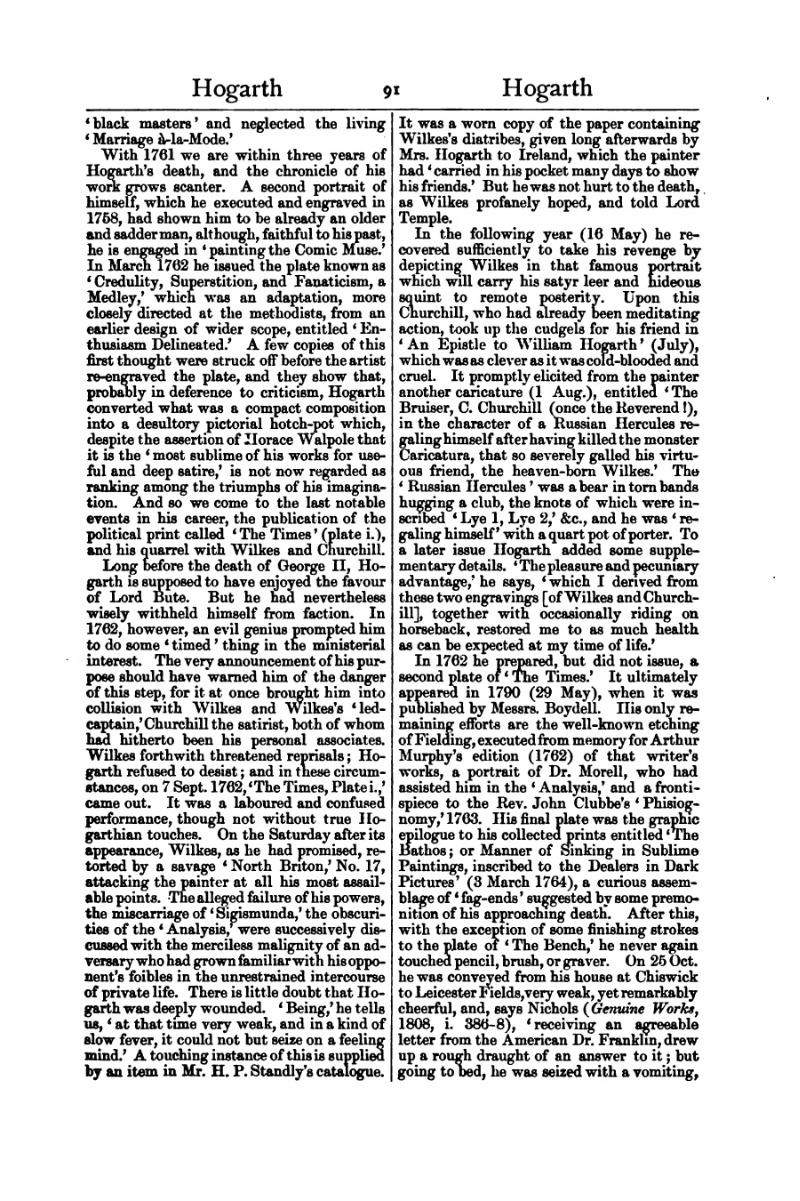‘black masters’ and neglected the living ‘Marriage à-la-Mode.’
With 1761 we are within three years of Hogarth's death, and the chronicle of his work grows scanter. A second portrait of himself, which he executed and engraved in 1758, had shown him to be already an older and sadder man, although, faithful to his past, he is engaged in ‘painting the Comic Muse.’ In March 1762 he issued the plate known as ‘Credulity, Superstition, and Fanaticism, a Medley,’ which was an adaptation, more closely directed at the methodists, from an earlier design of wider scope, entitled ‘Enthusiasm Delineated.’ A few copies of this first thought were struck off before the artist re-engraved the plate, and they show that, probably in deference to criticism, Hogarth converted what was a compact composition into a desultory pictorial hotch-pot which, despite the assertion of Horace Walpole that it is the ‘most sublime of his works for useful and deep satire,’ is not now regarded as ranking among the triumphs of his imagination. And so we come to the last notable events in his career, the publication of the political print called ‘The Times’ (plate i.), and his quarrel with Wilkes and Churchill.
Long before the death of George II, Hogarth is supposed to have enjoyed the favour of Lord Bute. But he had nevertheless wisely withheld himself from faction. In 1762, however, an evil genius prompted him to do some ‘timed’ thing in the ministerial interest. The very announcement of his purpose should have warned him of the danger of this step, for it at once brought him into collision with Wilkes and Wilkes's ‘led-captain,’ Churchill the satirist, both of whom had hitherto been his personal associates. Wilkes forthwith threatened reprisals; Hogarth refused to desist; and in these circumstances, on 7 Sept. 1762, ‘The Times, Plate i.,’ came out. It was a laboured and confused performance, though not without true Hogarthian touches. On the Saturday after its appearance, Wilkes, as he had promised, retorted by a savage ‘North Briton,’ No. 17, attacking the painter at all his most assailable points. The alleged failure of his powers, the miscarriage of ‘Sigismunda,’ the obscurities of the ‘Analysis,’ were successively discussed with the merciless malignity of an adversary who had grown familiar with his opponent's foibles in the unrestrained intercourse of private life. There is little doubt that Hogarth was deeply wounded. ‘Being,’ he tells us, ‘at that time very weak, and in a kind of slow fever, it could not but seize on a feeling mind.’ A touching instance of this is supplied by an item in Mr. H. P. Standly's catalogue. It was a worn copy of the paper containing Wilkes's diatribes, given long afterwards by Mrs. Hogarth to Ireland, which the painter had ‘carried in his pocket many days to show his friends.’ But he was not hurt to the death, as Wilkes profanely hoped, and told Lord Temple.
In the following year (16 May) he recovered sufficiently to take his revenge by depicting Wilkes in that famous portrait which will carry his satyr leer and hideous squint to remote posterity. Upon this Churchill, who had already been meditating action, took up the cudgels for his friend in ‘An Epistle to William Hogarth’ (July), which was as clever as it was cold-blooded and cruel. It promptly elicited from the painter another caricature (1 Aug.), entitled ‘The Bruiser, C. Churchill (once the Reverend!), in the character of a Russian Hercules regaling himself after having killed the monster Caricatura, that so severely galled his virtuous friend, the heaven-born Wilkes.’ The ‘Russian Hercules’ was a bear in torn bands hugging a club, the knots of which were inscribed ‘Lye 1, Lye 2,’ &c., and he was ‘regaling himself’ with a quart pot of porter. To a later issue Hogarth added some supplementary details. ‘The pleasure and pecuniary advantage,’ he says, ‘which I derived from these two engravings [of Wilkes and Churchill], together with occasionally riding on horseback, restored me to as much health as can be expected at my time of life.’
In 1762 he prepared, but did not issue, a second plate of ‘The Times.’ It ultimately appeared in 1790 (29 May), when it was published by Messrs. Boydell. His only remaining efforts are the well-known etching of Fielding, executed from memory for Arthur Murphy's edition (1762) of that writer's works, a portrait of Dr. Morell, who had assisted him in the ‘Analysis,’ and a frontispiece to the Rev. John Clubbe's ‘Phisiognomy,’ 1763. His final plate was the graphic epilogue to his collected prints entitled ‘The Bathos; or Manner of Sinking in Sublime Paintings, inscribed to the Dealers in Dark Pictures’ (3 March 1764), a curious assemblage of ‘fag-ends’ suggested by some premonition of his approaching death. After this, with the exception of some finishing strokes to the plate of ‘The Bench,’ he never again touched pencil, brush, or graver. On 25 Oct. he was conveyed from his house at Chiswick to Leicester Fields, very weak, yet remarkably cheerful, and, says Nichols (Genuine Works, 1808, i. 386–8), ‘receiving an agreeable letter from the American Dr. Franklin, drew up a rough draught of an answer to it; but going to bed, he was seized with a vomiting,
